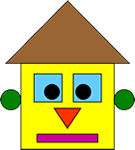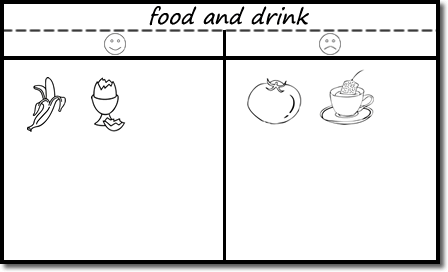Download a new song from ESL KidStuff: The Feelings Song
![The Feelings Song]() The Feelings Song
The Feelings Song
Song Theme: Talking about Feelings and Emotions
Target Vocab: happy, sad, hungry, angry, scared, sleepy, sunny, rainy, lunchtime, eat, yummy, noisy, stormy, bedtime, sleep, good night.
Song Length: 1:58
An original song focusing on feelings in certain situations. It has a nice, easy sing-along tune, and the last 2 verses have blanks where your students can sing the missing feelings words. Here is a sample:
Lyrics:
Verse 1:
When it’s sunny, I am happy,
When it’s rainy, I am sad,
When it’s lunchtime, I am hungry,
Time to eat, yummy!
Verse 2:
When it’s noisy, I am angry,
When it’s stormy, I am scared,
When it’s bedtime, I am sleepy,
Time to sleep, good night!
Verse 3:
When it’s sunny, I am ____________,
When it’s rainy, I am ____________,
When it’s lunchtime, I am ____________,
Time to eat, yummy!
Verse 4:
When it’s noisy, I am ____________,
When it’s stormy, I am ____________,
When it’s bedtime, I am ____________,
Time to sleep, good night!
Gestures and activities to use with the “The Feelings Song”
The actions for this reflect the situations and their associated feelings.
- “When it’s sunny” (do round circle shape with your arms), “I am happy” (smile)
- “When it’s rainy” (wriggle your fingers like rain), “I am sad” (look sad)
- “When it’s lunchtime” (rub your tummy), “I am hungry” (look hungry)
- “Time to eat“, (gesture eating), “yummy!” (look happy).
- “When it’s noisy” (cover your ears), “I am angry” (look angry)
- “When it’s stormy” (gesture under an umbrella), “I am scared” (look scared)
- “When it’s bedtime” (gesture sleeping – head sideways on pillow hands), “I am sleepy” (yawn with hand over mouth)
- “Time to sleep, good night!” (yawn and wave goodnight)
Using The Feelings Song in class
With all the simple actions, this is a really fun and popular song to do in your lessons, with all ages.
- Teach the feelings vocab. On the board draw a large circle.Then draw two eyes, ears, nose and a smiley mouth. Do the same facial gesture and say “I’m happy! Happy, happy, happy”. Get everyone to chorus “happy” and do the facial expression. Then erase the mouth and draw a sad mouth (and maybe a tear under one eye) and teach sad. Do the same for the rest of the vocab.
- Do “Draw the faces on the board”. Invite a student up to the front of the class and give him/her the chalk/marker. Whisper a feelings word (e.g. “angry”) and get him/her to draw the face in the circle. If he/she is having difficulty, show him a picture or flashcard. Invite the class to shout out the answers – the first student with the correct answer can draw the next picture.
- Play “Face draw” pairs. Put students in pairs and give each pair a large, blank sheet of paper. Have each pair draw circles on the paper. Then have them in turns draw faces with different emotions for their partners to guess. At the end of the activity invite some students to show the rest of the class their pictures and say what the feeling words are (or get the others to guess).
- Teach the rest of the song vocab. Before class, print flashcards for the following vocab: sunny, rainy, lunchtime, eat, yummy, noisy, stormy, bedtime, sleep, good night. Hold up the first card, say the word and do the action (see Gestures section above) and have everyone chorus the word and copy your gesture. Then stick the flashcard on the board. Do the same for all the flashcards and stick them on the board in the order of the song, in a line across the board. Once all the cards are on the board, point to any card and say “What’s this?”. Elicit the word. Keep pointing to flashcard randomly as the class shouts out the words, getting faster and faster. Finally, ask individual students what different cards are.
- Play “Missing Flashcard Guess”. With the flashcards still on the board, tell everyone to close and cover their eyes. Remove a card and hold it behind your back. Tell everyone to open their eyes and shout out the missing flashcard. Do this for the other cards at a quick pace.
- Match feelings to the situations. With the flashcards still on the board, ask the class how you feel when it’s sunny (e.g. ask “Do you feel angry when it’s sunny?” and do an angry face – hopefully everyone will respond “No! Happy”). Draw a happy face under the sunny flashcard. For each card elicit the feeling (from the song) and draw the face under each card.
- Practice actions of the song. Now we have all of the vocab on the board. Teach the actions for each word (see Gestures section above). Next, point to each picture on the board and get everyone to do the action.
- Sing The Feelings Song. Play the song through once and have everyone look at the pictures on the board (point as the song plays) and do the actions. Next, play the song again and sing along, encouraging everyone to sing as they do the actions.
- Do a “Feelings / Emotions” worksheet. To finish off this section of the lesson, give out worksheets which has the feelings vocab from the song. As your students are doing the worksheets, ask questions (e.g. “How does he/she feel?”, etc.). You can also give a worksheet for homework.
Related Stuff:
- Download all songs
- The Hello Song and The Goodbye Song
- The Numbers Song
- The ABC Song
- Head, Shoulders, Knees & Toes
- The Rainbow Song
- Old MacDonald
- What Can You Do?
- The Days of the Week Song
- Months March song
- How Did You Get Here Today? song
- Mr. Shape Head song
- Let’s Go to the Zoo
- What Fruit do you Like?
- Where are my Things?
- The Morning Routines Song
- If You’re Happy and You Know It
- The Directions Song
 The Feelings Song
The Feelings Song The Days of the Week Song
The Days of the Week Song
 Months March song
Months March song How Did You Get Here Today? song
How Did You Get Here Today? song Mr. Shape Head song
Mr. Shape Head song Let’s Go to the Zoo song
Let’s Go to the Zoo song Where are my Things?
Where are my Things? The Morning Routines Song
The Morning Routines Song If You’re Happy & You Know It
If You’re Happy & You Know It












